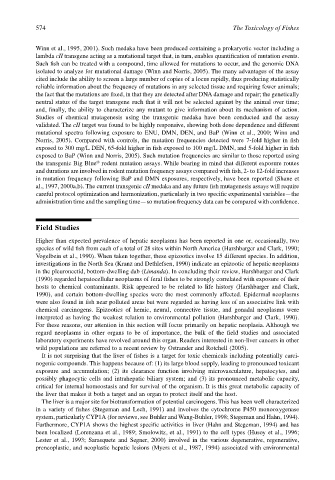Page 594 - The Toxicology of Fishes
P. 594
574 The Toxicology of Fishes
Winn et al., 1995, 2001). Such medaka have been produced containing a prokaryotic vector including a
lambda cII transgene acting as a mutational target that, in turn, enables quantification of mutation events.
Such fish can be treated with a compound, time allowed for mutations to occur, and the genomic DNA
isolated to analyze for mutational damage (Winn and Norris, 2005). The many advantages of the assay
cited include the ability to screen a large number of copies of a locus rapidly, thus producing statistically
reliable information about the frequency of mutations in any selected tissue and requiring fewer animals;
the fact that the mutations are fixed, in that they are detected after DNA damage and repair; the genetically
neutral status of the target transgene such that it will not be selected against by the animal over time;
and, finally, the ability to characterize any mutant to give information about its mechanism of action.
Studies of chemical mutagenesis using the transgenic medaka have been conducted and the assay
validated. The cII target was found to be highly responsive, showing both dose dependence and different
mutational spectra following exposure to ENU, DMN, DEN, and BaP (Winn et al., 2000; Winn and
Norris, 2005). Compared with controls, the mutation frequencies detected were 7-fold higher in fish
exposed to 300 mg/L DEN, 65-fold higher in fish exposed to 100 mg/L DMN, and 5-fold higher in fish
exposed to BaP (Winn and Norris, 2005). Such mutation frequencies are similar to those reported using
®
the transgenic Big Blue rodent mutation assays. While bearing in mind that different exposure routes
and durations are involved in rodent mutation frequency assays compared with fish, 2- to 12-fold increases
in mutation frequency following BaP and DMN exposures, respectively, have been reported (Shane et
al., 1997, 2000a,b). The current transgenic cII medaka and any future fish mutagenesis assays will require
careful protocol optimization and harmonization, particularly in two specific experimental variables—the
administration time and the sampling time—so mutation frequency data can be compared with confidence.
Field Studies
Higher than expected prevalence of hepatic neoplasms has been reported in one or, occasionally, two
species of wild fish from each of a total of 28 sites within North America (Harshbarger and Clark, 1990;
Vogelbein et al., 1990). When taken together, these epizootics involve 15 different species. In addition,
investigations in the North Sea (Kranz and Dethlefsen, 1990) indicate an epizootic of hepatic neoplasms
in the pleuronectid, bottom-dwelling dab (Limanda). In concluding their review, Harshbarger and Clark
(1990) regarded hepatocellular neoplasms of feral fishes to be strongly correlated with exposure of their
hosts to chemical contaminants. Risk appeared to be related to life history (Harshbarger and Clark,
1990), and certain bottom-dwelling species were the most commonly affected. Epidermal neoplasms
were also found in fish near polluted areas but were regarded as having less of an associative link with
chemical carcinogens. Epizootics of hemic, neural, connective tissue, and gonadal neoplasms were
interpreted as having the weakest relation to environmental pollution (Harshbarger and Clark, 1990).
For these reasons, our attention in this section will focus primarily on hepatic neoplasia. Although we
regard neoplasms in other organs to be of importance, the bulk of the field studies and associated
laboratory experiments have revolved around this organ. Readers interested in non-liver cancers in other
wild populations are referred to a recent review by Ostrander and Rotchell (2005).
It is not surprising that the liver of fishes is a target for toxic chemicals including potentially carci-
nogenic compounds. This happens because of: (1) its large blood supply, leading to pronounced toxicant
exposure and accumulation; (2) its clearance function involving microvasculature, hepatocytes, and
possibly phagocytic cells and intrahepatic biliary system; and (3) its pronounced metabolic capacity,
critical for internal homeostasis and for survival of the organism. It is this great metabolic capacity of
the liver that makes it both a target and an organ to protect itself and the host.
The liver is a major site for biotransformation of potential carcinogens. This has been well characterized
in a variety of fishes (Stegeman and Lech, 1991) and involves the cytochrome P450 monooxygenase
system, particularly CYP1A (for reviews, see Buhler and Wang-Buhler, 1998; Stegeman and Hahn, 1994).
Furthermore, CYP1A shows the highest specific activities in liver (Hahn and Stegeman, 1994) and has
been localized (Lorenzana et al., 1989; Smolowitz, et al., 1991) to the cell types (Husoy et al., 1996;
Lester et al., 1993; Sarasquete and Segner, 2000) involved in the various degenerative, regenerative,
preneoplastic, and neoplastic hepatic lesions (Myers et al., 1987, 1994) associated with environmental

